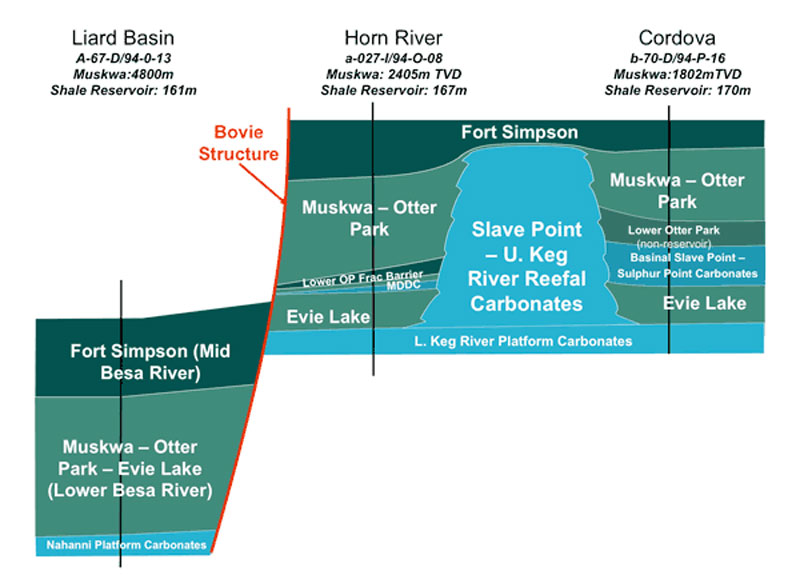Horn River Basin
Horn River Basin
About Horn River Basin
Horn River Basin
The Horn River Basin is a dry natural gas basin that encompasses 1.1 million hectares, and contains several separate shale formations: the Evie, Klua, Otter Park, and Muskwa Shales. These shales lie at vertical depths between 6500’-13000’. Horizontal drilling in the Horn River began in earnest in 2008.
Experts estimate there is about 250 trillion cubic feet (tcf) of natural gas in the field, of which 10% to 20% is recoverable. Another emerging shale play in British Columbia, just south of the Horn River shale, is the Montney shale, which is estimated to hold up to 50 tcf of gas reserves and extends east into Alberta.

Evaluation and Strategies
Gas producing Devonian-Mississippian age strata in northeastern British Columbia have been described as thermally mature silicious shales. Shale gas production from the Horn River formation is well documented, along with the laterally equivalent Besa River, Muskwa and Fort Simpson.
Formation thicknesses of 500 feet and more represent enormous reservoir potential.
Rocks that are both silica rich and that have total organic content (TOC) of 5-plus percent are considered most favorable for shale gas reservoir exploration due to the rock propensity for enhanced fracturing of brittle, organic-rich and silica-rich facies, according to the integrated formation evaluation report of Ross and Bustin, University of British Columbia (AAPG BULLETIN, January 2008).
In other words, rock intervals that have higher carbonate and silica content may be expected to respond favorably to fracture stimulation.
Thanks in part to the credit program, Nexen Inc. has doubled its position in northeastern British Columbia to 90,000 acres – 10 percent of the company’s global holdings.
Ron Bailey, Nexen’s general manager for shale gas, describes the Horn River Shale as having “great rock quality – 50 percent thicker even than the Barnett.”
Bailey evaluates shale gas reservoir rock by five criteria:
- Gas in place per section.
- Estimated EUR per well.
- Fracability – the Horn River Shale is a more fracable reservoir rock due to its higher silica content, two to three times greater than the Barnett Shale.
- Gas quality – this is a negative factor in the Horn River Shale, having 10-12 percent CO2 that must be extracted before pipeline transport.
- Reservoir productivity – the Horn River is highly productive.
“Nexen’s interest in the area has increased as we have learned more about production strategies,” Bailey said. “And by drilling larger programs, our costs have decreased while our confidence has increased.”
Nexen will soon deploy an eight-well drilling pad with an average of 18 fracs per well. According to Bailey, “Our frac program achieved an industry leading pace of 3.5 fracs per day.”
- See more at: http://www.aapg.org/publications/news/explorer/column/articleid/2869/horn-river-basin-keeping-canada-hot#sthash.2MnRRWRm.dpuf
Pipeline Infrastructure
New pipeline construction projects are now under way or planned to connect British Columbia shale gas resources to global markets.
TransCanada kicked off construction Aug. 6 on the first pipeline to cross the Alberta-British Columbia border. The Groundbirch pipeline project will connect natural gas supplies in the Horn River Basin in northeast British Columbia to the Alberta system. The $200-300 million project is scheduled for completion by November 2012.
A planned Pacific Trail Pipeline will move gas from northeast British Columbia to Kitimat, British Columbia, where the Kitimat LNG export terminal will open to the rapidily growing economies of the Asia Pacific export markets.
Kitimat’s terminal is approximately 400 miles north of Vancouver, offering a shorter, less expensive shipping route across the north Pacific. Natural gas will be cooled and liquefied at the terminal for export via ship to growing, natural gas markets in South Korea, Japan, China and Southeast Asia.
“When completed, the Kitimat LNG export terminal will provide a new market-demand outlet for British Columbia, a critical factor in the commercial development of the Horn River shale gas play,” said Mike Dawson, president of the Canadian Society for Unconventional Gas.
Kitimat is designed to be linked to the pipeline system servicing Western Canada’s natural gas producing regions via the proposed Pacific Trail Pipelines, a $1.1-billion (Canadian), 300-mile (463-kilometer) project.
- See more at: http://www.aapg.org/publications/news/explorer/column/articleid/2869/horn-river-basin-keeping-canada-hot#sthash.2MnRRWRm.dpuf

